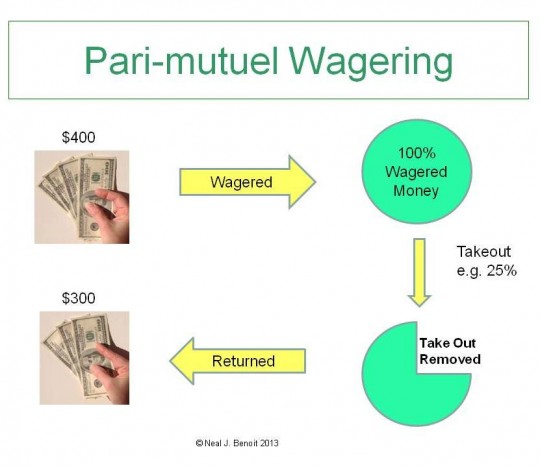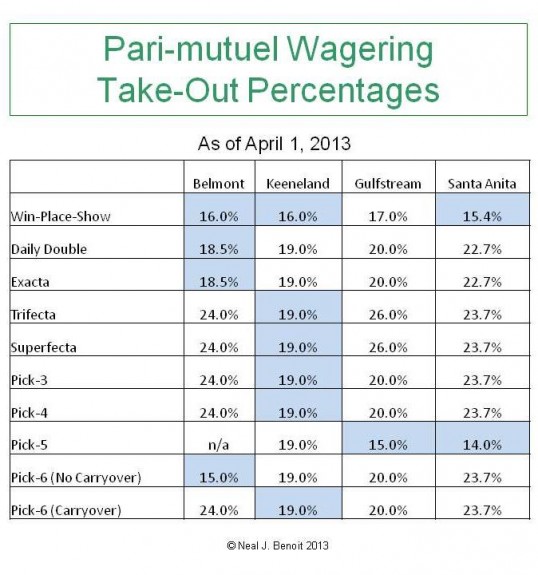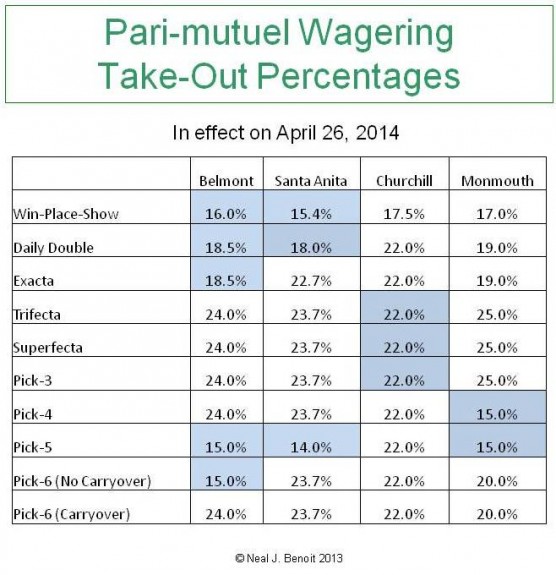Takeout Rates, Churchill Downs, and Comparisons by Racetrack
The system of betting that is standard throughout the horse racing world is based on pari-mutuel wagering. All money wagered is placed into a pool, a “Take-Out” is removed from the pool, and the remaining money is returned to the winning wagers. The diagram below shows an example with the assumption of a 25% takeout rate and a total of $400 wagered.

In the example above, for every $400 wagered by the betting public, only $300 is returned to the holders of winning tickets. So where does the other $100 go? It pays the participants in the sport; owners, trainers, public handicappers, tellers, bathroom attendants, and of course the tax-man. Additionally, there are operational costs and overhead for the maintenance of the track facilities.
Takeout varies by the type of bet and the racetrack where the bet is placed. The differences can be significant, ranging from roughly 15% to 26% in the United States. In the past rates were generally less for “simple” wagers like Win, Place, and Show and higher for “exotic” wagers like Trifecta, Superfecta, and Pick-X races. But, that is not always the case presently – as you will see in a chart we first published in 2013 showing takeout percentages from a few of the major tracks in North America.
Obviously the less money taken out, the better for the bettors. With that in mind, I’ve highlighted the best rates available for each type of wager. As you can see from the chart, there is no agreed upon standard in the horse racing industry. For the infrequent visitor to the racetrack, takeout rates aren’t a big concern, but for regular horseplayers it directly affects their bottom line.
Takeout percentages are an ongoing topic of debate in the Horse Racing industry. What is the proper amount to pay for the necessary costs, yet still give a regular horseplayer a fighting chance of turning a profit … and thereby keep him interested in the game?
Churchill Downs just announced that beginning in 2014, they are increasing their takeout rates to the maximum amount allowed by Kentucky law. Click here to read an article recently published in Blood Horse about this increase. This of course sparked an outcry from many regular horseplayers. All you have to do is read some of the comments made in the Blood Horse article or another article published by Daily Racing Form to see how irate some fans appear to be.
Last year the takeout rates for Churchill Downs were identical to those listed for Keeneland in the above chart. Below is a new chart with updated rates for 2014. This chart includes three other major racetracks that will be running meets concurrently with Churchill Downs this year.
You can see that despite the increase, Churchill remains competitive in three bet types (Trifecta, Superfecta, and Pick-3). However, in several other categories their new rates are several percentage points higher than their competition. Time will tell if this change by Churchill Downs helps or hurts them in the long run. While the higher takeout rates will increase their revenues per wager, the impact on the total dollars wagered (aka the handle) will ultimately determine whether or not this change was wise.



6 comments on “Takeout Rates, Churchill Downs, and Comparisons by Racetrack”